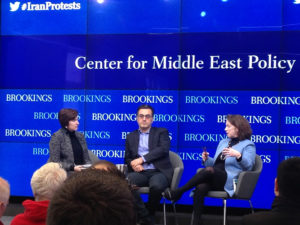A Certain Uncertainty: Brookings Holds Discussion on Recent Iranian Protests

Amid two weeks of protest in Iran, the Brookings Institution’s Center for Middle East Policy hosted Iranian-Canadian journalist and filmmaker Maziar Bahari in a talk with Brookings Deputy Director for Foreign Policy Suzanne Maloney on Friday, January 5, 2018. The discussion moderated by Politico’s Susan B. Glasser, addressed the present upheaval in Iran and its implications for the country’s stability, its politics, and the broader international community.
The talk drew distinctions between the 2009 Green Movement and the smaller ongoing demonstrations. Whereas 2009’s protesters demanded an electoral recount, the new demonstrations have lacked a central complaint but have struck a more despondent note. Protesters have destroyed images of Supreme Leader Ayatollah Ali Khamanei and Islamic Revolutionary Guard Corps (IRGC) Commander Qassem Soleimani. They’ve chanted “Death to the Dictator!” and damaged public buildings. But so far, they have not agreed on any agenda for reform. “They know what they do not want. But I have not heard one slogan about what they want,” said Bahari, who was jailed for 118 days without charge in 2009 and whose memoir, Then They Came for Me, was adapted into the 2014 film Rosewater.
The present unrest has scrambled Iran’s traditional coalition politics. Bahari noted that the protesters are largely young, unemployed, and have “nothing to lose,” and that their violent actions, including burning government mosques, have alienated many middle-class Iranians who demonstrated in 2009. Those Iranians, many of whom identify with reformist President Hassan Rouhani, now stand at odds with protesters who mainly hail from demographic groups more friendly to Iran’s conservatives and the clerical regime. “It’s almost like the Iranian version of Trump country,” commented Glasser. Though participation is weaker, violent protest from the regime’s key constituencies has alarmed Iran’s conservative authoritarian establishment.
Maloney, who is the deputy director of Brookings’ foreign policy program and a senior fellow at the Center for Middle East Policy, discerned a collapse of popular legitimacy and a threat to President Rouhani’s agenda in the renewed protests. “Rouhani was the last, best attempt to try to moderate the Islamic Republic,” she said, warning that the tension between Iran’s representative and authoritarian institutions has not been resolved. Hardline elements within the Iranian regime have stymied Rouhani’s attempts at economic reform. As a result, the 2015 nuclear deal (which was touted as a transformative moment for the Iranian economy) has failed to produce widely anticipated gains for average Iranians. Contemporary protests rooted in economic distress only highlight this further.
The speakers also discussed the US response to the protests, offering qualified praise for President Donald Trump’s public support for demonstrators. Maloney noted that the United States’ abandonment of democracy promotion as a general principle made it hard to avoid charges that the US position is purely opportunistic. The Iranian regime frequently attempts to delegitimize popular opposition by linking it to alleged American and Israeli conspiracies to overthrow the government. The Obama administration recognized the precariousness of the 2009 demonstrations and accordingly offered a quiet response, which was met with criticism. “Lesson learned,” Maloney stated. “We should never stay on the sidelines.”
Bahari speculated that Iran will cease highlighting its military achievements abroad, as the recent demonstrations have expressed deep dissatisfaction with Iranian foreign adventurism. Iranian involvement in Syria, Lebanon, Iraq, and Yemen has grown increasingly visible and increasingly costly in recent years. The Iranian regime has attempted to turn this liability into an expression of public strength and solidarity with its allies, touting its victories and encouraging support for the families of fallen soldiers. As public pressure mounts against the unequal distribution of Iranian resources between its military and social safety nets, increased consciousness of the costs Iran bears in projecting its agenda abroad may make it harder for the regime to justify its international actions.
Since the Brookings’ discussion, President Rouhani has come out in favor of citizens’ right to protest and called attention to their economic and social grievances. As of yet the protest movement is too small to pose a serious risk to Iranian regime survival. But maneuvering around the suppression or support of demonstrators could further shake Iran’s delicate governing balance between elected reformists and Iran’s unaccountable clerical and military institutions. Iranian politics has perhaps never been so consolidated, with two reformist (broadly more liberal) and principalist (broadly more conservative) political coalitions now controlling a healthy majority of the Iranian parliament. The protests frustrate popular expectations about who supports these two camps and could point to a realignment of voters in Iran.
Furthermore, the protests have highlighted the harm inflicted on religion by Iran’s total lack of church-state separation. “There is a sentiment among Iranians to reject everything this government stands for. That includes the Islamic Republic… they reject Islam itself,” Bahari warned, noting a cultural shift towards irreligiosity and Zoroastrian revival among Iranians fed up with the Islamist government. Iran’s increasing reliance on force to suppress dissent can only further damage popular perception of the official Twelver Shi’a religion, which has a rich and still not entirely suppressed history of diverse interpretation by clerics and individual believers.
Whatever the outcome of the current wave of Iranian protests, the discussion at the Center for Middle East Policy at Brookings in Washington, DC, strongly indicated that unpredictable and decentralized unrest in Iran is likely to persist for some time. “No one knows who are exactly the people in demonstrations,” said Bahari. With tens of thousands of people in at least fifty-four cities participating in demonstrations and a clear disconnect between protesters and the Iranian elites (whose experiences are more commonly depicted in media), the situation in Iran looks likely to become more uncertain.
